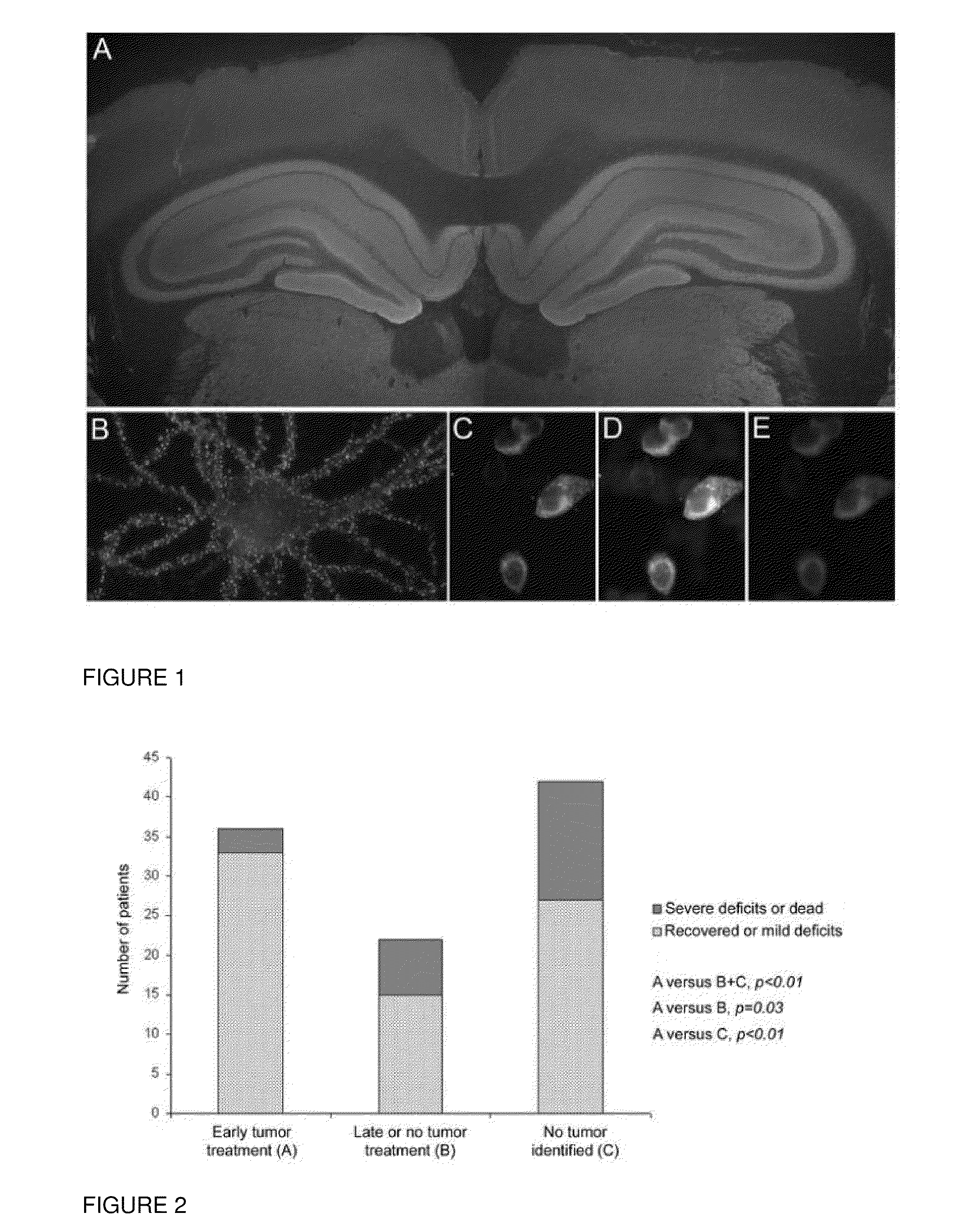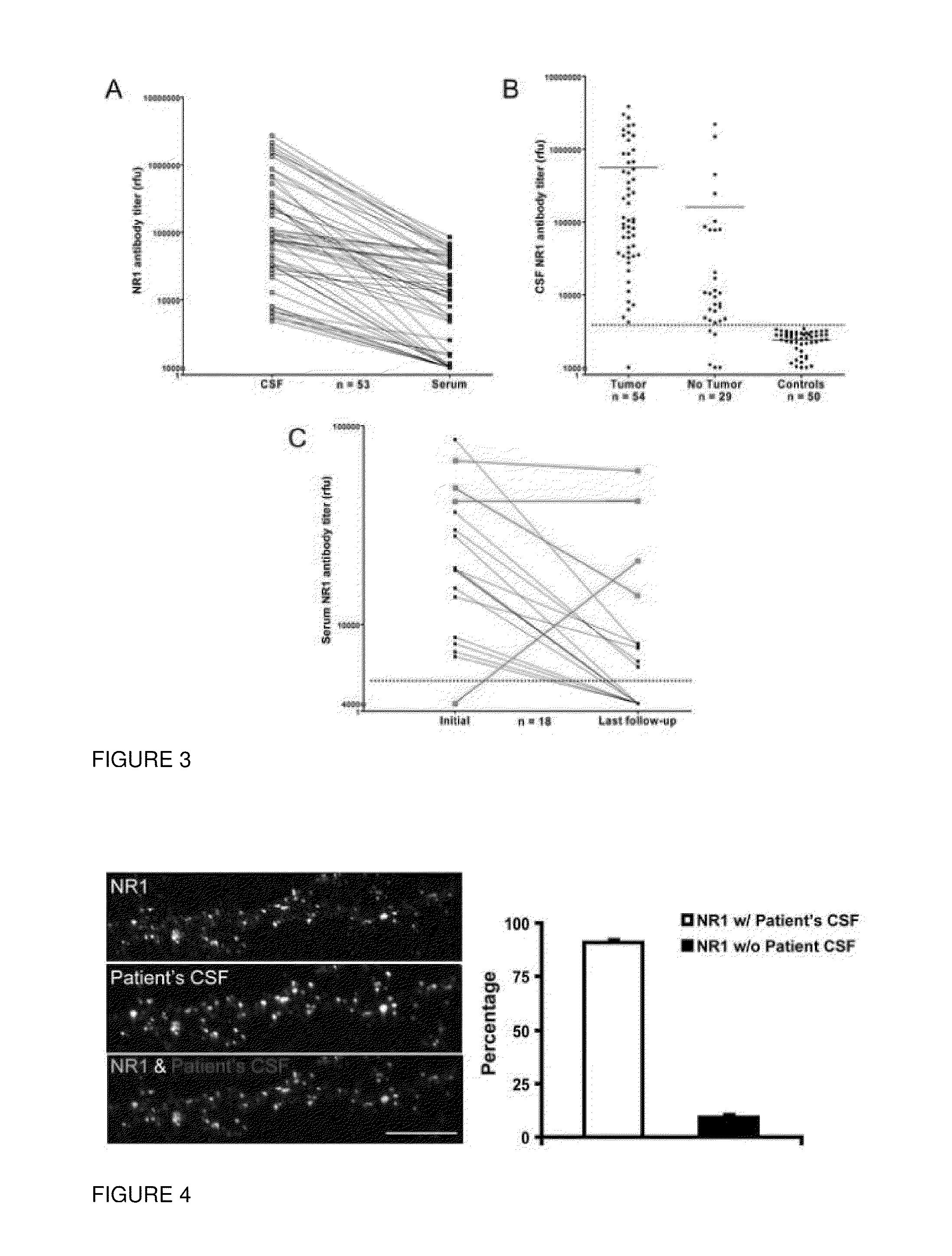Methods and compositions for treatment and diagnosis of encephalitis or epilepsy
a technology of encephalitis and epilepsy, applied in the field of methods of diagnosing and treating an autoimmune encephalitis or an epilepsy, can solve the problems of poor response to immunotherapies or treatmen
- Summary
- Abstract
- Description
- Claims
- Application Information
AI Technical Summary
Benefits of technology
Problems solved by technology
Method used
Image
Examples
example 1
Neurological Syndrome
[0101]Clinical information is shown in Table 1. Eighty-six percent of patients had headache, low-grade fever, or a non-specific viral-like illness within two weeks before hospital admission. Seventy-seven patients presented with prominent psychiatric symptoms, including anxiety, agitation, bizarre behavior, delusional or paranoid thoughts, and visual or auditory hallucinations. Twenty-three patients presented with short-term memory loss or seizures alone or associated with psychiatric manifestations. During the first three weeks of symptom presentation 76 patients had seizures. Subsequently 88 patients developed decreased level of consciousness, progressing to a “catatonic-like state”, with periods of akinesis alternating with agitation, and diminished or paradoxical responses to stimuli (e.g., no response to pain but resisting eye opening). Some patients mumbled unintelligible words or had echolalia. Eye contact or visual tracking was absent or inconsistent. Du...
example 2
Tumor Association
[0103]Fifty-eight of 98 patients (59%) had a neoplasm (Table 1); two died before tumor evaluation. All but one of these patients developed neurological symptoms before the tumor diagnosis (median 8 weeks, range 1-380 weeks). In 6 patients, the tumor was diagnosed after recovery from the encephalitis (56-380 months). In 53 patients, the tumor was a teratoma of the ovary (median size 6 cm, range 1-22), identified with CT, MRI, or ultrasound. Eight patients had bilateral teratomas; 4 were synchronous, 2 had history of a contralateral teratoma, and 2 developed contralateral teratomas heralding recurrence of the encephalitis. All teratomas contained nervous tissue; 25 were examined for expression of NMDA receptors, and all were positive.
[0104]One boy (11 years old, without tumor) and 21 women were younger than 19 years (median 15, range 5-18); 12 had an ovarian teratoma (5 immature) and 9 had no tumor. Metastases were identified only in one man with immature teratoma of ...
example 3
Treatment and Outcome
[0105]Fifty-one patients had tumor resection and 7 did not (1 small-cell lung cancer, 2 teratomas found at autopsy, 4 not removed). All but 6 patients who had tumor removal received one or more immunotherapies (Table 1). Similar immunotherapies were used in 40 of 42 patients without tumor and 2 had supportive care. The median follow-up was 17 months (1-194): 47 patients had full recovery, 28 mild stable deficits, 18 severe deficits, and 7 died as a result of the neurological disorder. Patients whose tumor was identified and removed within the first 4 months of the onset of the neurological disease had better outcome than the rest of the patients (p<0.01; FIG. 2, and Table S1). The median time from symptom presentation to initial signs of improvement was 8 weeks (range 2-24) for the group of patients with early tumor treatment, 11 weeks (4-40) for the group whose tumor was treated late or not treated, and 10 weeks (2-50) for the group without tumor (Kruskal-Walli...
PUM
| Property | Measurement | Unit |
|---|---|---|
| time | aaaaa | aaaaa |
| pH | aaaaa | aaaaa |
| pH | aaaaa | aaaaa |
Abstract
Description
Claims
Application Information
 Login to View More
Login to View More - R&D
- Intellectual Property
- Life Sciences
- Materials
- Tech Scout
- Unparalleled Data Quality
- Higher Quality Content
- 60% Fewer Hallucinations
Browse by: Latest US Patents, China's latest patents, Technical Efficacy Thesaurus, Application Domain, Technology Topic, Popular Technical Reports.
© 2025 PatSnap. All rights reserved.Legal|Privacy policy|Modern Slavery Act Transparency Statement|Sitemap|About US| Contact US: help@patsnap.com



